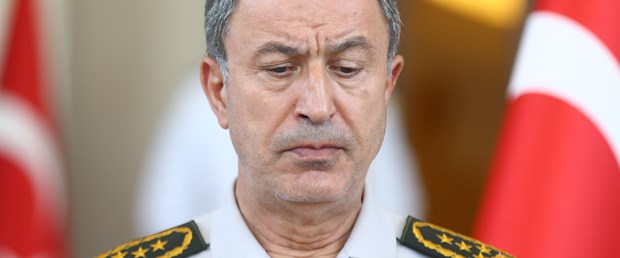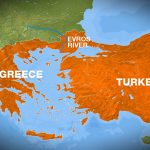New evidence obtained by Nordic Monitor shows then-Chief of General Staff and current Defense Minister Hulusi Akar as the head of the putschist group that issued mobilization orders and declared marshal law in Turkey on July 15, 2016.
The secret documents obtained from a computer at the General Staff headquarters that was used to write the coup statement included draft versions signed by Akar himself on behalf of the Council of Peace in the Homeland (Yurtta Sulh Konseyi), the name the putschists gave themselves. In one document he was identified as president of the council, while in another draft his name was removed but the word “signed” was inserted, bolstering the view that the chief of general staff actually signed the directive.

The members of the Council of Peace in the Homeland were never identified despite the fact that thousands of officers who were apparently not involved in the putschist mobilization have been investigated, indicted and convicted on dubious coup and terrorism charges since 2016 when the coup attempt was mysteriously launched during prime time with bizarre moves such as blocking the bridge between the European and Asian sides of Istanbul. The political accomplices who are required for every putschist group to sustain a post-coup regime were not uncovered, either, suggesting a deliberate hush-up and a conspiracy of foul play in the planning, which was designed to create a pretext for the government to set up a mass persecution of its opponents.
In the version that was transmitted through secure channels, the council name was at the end of the three-page directive, which was communicated with further orders. The version that was announced later by the public broadcaster and posted on the website of the Turkish Armed Forces (TSK) was circulated as signed by the council without mentioning Akar’s name, although other drafts included his name and signature.
As anticipated, that created confusion among generals and admirals who received the initial orders from headquarters that were transmitted using the Turkish military’s secure communication channel, MEDAS. The transmitted message included the title of brigadier general as the officer who approved the message, which was unusual given the fact that the directives mentioned reassignments in the superior ranks, i.e., at the level of general and admiral.
In other words, the way the directive was written by the lower ranking officer, giving duty assignments to higher ranking officers, went against the chain of command. If the draft directive with Akar’s name had been transmitted, the coup would have succeeded given the sheer power projected by the Turkish military that no other force in the country can challenge. Many commanders in the field found the message suspicious, questioned the chain of command, did not participate in the coup or the military mobilization, which was limited to only 1 percent of the Turkish military. The operation, designed to fail from the start according to experts, was contained easily and quickly.
Although his name was listed in the seized documents as the man who directed the coup attempt, Akar was not charged and was not put on the stand for cross-examination. He was summoned by opposition party lawmakers in parliament who were investigating the coup, but Akar refused to appear. When criticism mounted over his failure to cooperate, he sent a written explanation but did not show up at the hearing held by the parliamentary commission.
The coup bid took place under his watch; yet, he was not held accountable for the comical events that took place at the heart of the military, the General Staff headquarters. Instead, he was promoted to defense minister in Erdoğan’s new cabinet, and the entire military apparatus was placed in his portfolio with new legal changes. The documents were examined by an expert from the police department and submitted to the court during the coup trials, but neither the prosecutors nor the judges questioned why Akar’s name was indicated as the signatory in the martial law directives.
The ambiguity in communications and the existence of various drafts appear to have lent credence to claims that Akar was in fact conspiring with the government to orchestrate a false flag coup and wanted to create the impression that there was actually an attempt made to stage a real coup. Some officers were misled into believing that Akar was running the show and joined in the attempt, only to find out later that they were duped, according to accounts provided by some observers. If that was the case, the General Staff did its job and helped create that perception while undermining the real mobilization to topple the government in order to ensure the failure of the attempt from the beginning.
According to the expert report on the various drafts that was submitted on March 14, 2017 to the prosecutor as part of coup investigation case file No. 2016/103566 , it looks like the officers who worked at the General Staff used templates in drafting various orders that were transmitted to army branches. Templates prepared in advance were used in the coup statement that declared marshal law. According to the document properties in Microsoft Word, the templates of different versions were created long before the event took place on July 15, 2016. It appears these templates were repeatedly used for writing various directives from the General Staff under the order of the commanders at the headquarters.
The first messaging document that was created at 22:15:24 under the name DİREKTİF MESAJ FORMATI.doc was transformed into the standard format used in the MEDAS messaging system. It was stamped very urgent (Harekat Yıldırım) and classified as secret. Since the secure messaging system in the Turkish military requires the signatures of the officer who wrote the directive and the superior officer who approved it before transmittal to army branches, the draft order carried the signature of Col. Cemil Turhan as the author and Mehmet Partigöç as the brigadier general who cleared the message. At the end of the text of the message, it stated that it was “signed” (İmzalıdır) on top of the words “President of the Council of Peace.” In the postscript, a new assignment order was attached to the directive in addition to the three other annexes seen in the other draft versions
Some half an hour later, the same author recorded the same document without using the MEDAS format. It appears he simply used the “save” function for the Word document to register the body of the text under a different name.
This version of the marshal law directive was written at 22:45:34 using the template according to the meta tag data of the two Microsoft word documents titled SIKIYÖNETİM DİREKTİFİ.doc and SIKIYÖNETİM DİREKTİFİ (2).doc. They were only signed at the end of the three-page document with the Council of Peace in the Homeland as the name of the signatory. The postscript indicated three annexed documents – the list of commanders assigned under marshal law (EK-A), the assignment list for marshal law courts (EK-B) and the law enforcement plan and reinforcements for the cities of Ankara and Istanbul (EK-C) — to be sent along with the marshal law directive.
In the documents titled DİREKTİF YAZI FORMATI.doc and DİREKTİF YAZI FORMATI (2).doc, both of which were typed at 23:38:12 and classified as secret, Akar’s name was seen in the signature section as the president of the Council of Peace in the Homeland. The two documents were identical.
This draft was written some 45 minutes after the previous one and Akar’s name was inserted into the coup directive. Standard operating procedure in the military requires Akar to approve such a change as he was known to run a tight ship at headquarters.
In the last draft document titled DİREKTİF MESAJ FORMATI (2) which was created at 01:36:18 on July 16, 2016, the directive was signed by Chief of General Staff Gen. Hulusi Akar as the president of the Council of Peace in the Homeland.
In his testimony as a witness in the prosecutor’s office on July 18, 2016, Akar claimed he was under detention although that allegation was refuted during court proceedings, and CCTV footage from inside the headquarters showed him moving freely without any restraint. He also said he was asked to sign the coup directive document but refused when Adm. Ömer Faruk Harmancık read him out loud what Akar said was a two-page document. However, the expert report that included all versions of the directives is three pages long, not two as Akar claimed. Many of Akar’s allegations in his testimony were challenged by other officers in the courtroom during the hearings, and he did not appear as a government witness in those proceedings.
The evidence seems to confirm the widely circulated alegations that Akar had in fact been working with Turkish intelligence chief Hakan Fidan and President Recep Tayyip Erdoğan to stage a false flag coup in a controlled fashion in order to create a pretext for an unprecedented mass purge of officers from NATO’s second largest army in terms of manpower. The failed coup helped Erdoğan to dismiss pro-NATO officers from the army including some 70 percent of all generals and admirals regardless of their position in the coup. They were replaced by Islamists and neo-nationalists who are hostile to the transatlantic alliance.
This explains why Akar and Fidan had mysteriously long meetings on July 14 and July 15. The first meeting was held during the Special Forces Expertise Training (ÖKİK-4) graduation ceremony, which had been moved to July 14, a day early and highly unusual. Chief of General Staff Akar and Deputy Chief of General Staff Yaşar Güler were present for the ceremony. The surprise was the participation of National Intelligence Organization (MİT) chief Fidan, which looked very suspicious. Once the program was over, it was time for dinner. Two important meetings were held that night. The first was between Akar, Güler, Fidan and then-ÖKK commander Lt. Gen. Zekai Aksakallı. Afterwards, Akar and Fidan had a private meeting between 20:30 and 00:30, which was most unusual and remarkably long.
The surprise meetings of the night were not over. After Akar left, Fidan and Aksakallı talked for an hour as they walked together from the security gate of the Special Forces Command towards the FNSS Defense Systems A.S. building. This was very unusual as well. It was obvious that something extraordinary was going on.
On July 15, Fidan went to see Akar in person before 18:00 and spent some three hours at the General Staff headquarters. Considering the dinner and the private meeting at the graduation ceremony for the trainees in the Special Forces Command the previous day, the heads of the two security organizations spent almost nine hours together in a 24-hour period.
Although it was alleged that the putschists who planned a risky operation like raiding the MİT headquarters with three helicopters to capture Fidan, they did not touch Fidan when he was in the General Staff headquarters for hours. It would have been very easy to detain the MIT head at the General Staff when he was in the same building with the putschists for such a long period of time. What is more, the putschists had already launched the coup while Fidan was still at General Staff headquarters.
Source: Nordic Monitor



